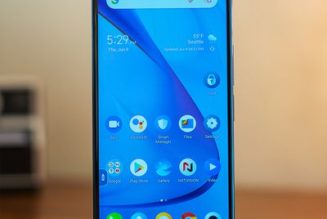
Today let’s talk about a concept that we can all agree is well defined and no one is yet sick of talking about: the metaverse.
OK, maybe you are a little tired of hearing about it. For a company often accused of being unable to do anything but copy, Facebook-now-Meta’s announcement this summer that it would pivot to the metaverse has already inspired a remarkable number of clones. As David Pierce notes at Protocol today, the tech world has recently announced “a fashion metaverse, an industrial metaverse, an entertainment metaverse, a gaming metaverse, [and] a shark metaverse.” (He forgot Match Group’s forthcoming dating metaverse, though in fairness I’m trying to forget it too.)
But as oppressive as this wave of announcements can feel, they also tell us something important: this trend — a set of next-generation, portable internet experiences centered on virtual reality headsets and augmented reality glasses — is much bigger than any one company. The more companies that begin to build their pieces of this world, after all, the more likely it is that some of them will succeed. And the ones who succeed in the end might be different than the one we expect at the start.
One company that would seem to be well positioned to capitalize on this trend is Niantic Labs, which was created as an internal startup at Google in 2010 and was spun out as an independent company five years later. I first wrote about Niantic in 2013 in the context of its first game, the science fiction-flavored Ingress. But the company got much bigger three years later when it launched Pokémon Go, which became a cultural phenomenon and generated more than $6 billion in revenue (as of last year) along the way.
From the beginning, Niantic has had all the makings of a metaverse company. Its core products lay animations on top of the real world using software and smartphones. And this year the company announced that it is building a reference design for its own AR glasses, joining companies including Meta and Snap.
And yet when it comes to the metaverse itself, the company is not a fan. “The Metaverse is a Dystopian Nightmare. Let’s Build a Better Reality,” read the headline on a company blog post this summer. CEO John Hanke explained himself this way:
As a society, we can hope that the world doesn’t devolve into the kind of place that drives sci-fi heroes to escape into a virtual one — or we can work to make sure that doesn’t happen. At Niantic, we choose the latter. We believe we can use technology to lean into the ‘reality’ of augmented reality — encouraging everyone, ourselves included, to stand up, walk outside, and connect with people and the world around us. This is what we humans are born to do, the result of two million years of human evolution, and as a result those are the things that make us the happiest. Technology should be used to make these core human experiences better — not to replace them.
Hanke elaborated today in an interview with Steven Levy at Wired:
It takes us away from what fundamentally makes us happy as human beings. We’re biologically evolved to be present in our bodies and to be out in the world. The tech world that we’ve been living in, as exacerbated by Covid, is not healthy. We’ve picked up bad habits—kids spending all day playing Roblox or whatever. And we’re extrapolating that, saying, “Hey, this is great. Let’s do this times 10.” That scares the daylights out of me.
Despite those fears, what Niantic is building is very much consistent with what rivals like Meta and Snap are pursuing. And as of today, the company is inviting other developers to come help realize its vision. During a virtual event this morning, Niantic announced Lightship, an “ARDK” — augmented reality development kit — designed to help developers build experiences using the same building blocks Niantic uses to build Pokémon.
If you’ve played that game, you know that Niantic understands how to place a cartoon character in your immediate surroundings and create ways for you to interact with it — throwing a Poké Ball at a wild Pikachu, for example. But when it launched, the technology could not distinguish between whether you were indoors or outdoors, on grass or on gravel, or whether a large body of water was right next to you.
Lightship offers a way to help developers understand those elements and build custom games and other experiences around them. The long-term goal is to create a crowdsourced, three-dimensional map of the world. In the meantime, the idea is to create software that adapts to your surroundings. If you’re standing on the beach, maybe your phone shows you a monster coming out of the water. If you’re on dry land, maybe that same monster claws out of the grass. Or if you’re indoors, maybe a virtual ball bounces off the table in front of you.
To anyone who has played a recent console or PC game, none of this may sound particularly inspiring. Niantic’s work here is very much state of the art, but the state of the art is primitive compared to the visions that tech companies keep painting for us in their keynotes. As someone who has spent 30 years watching video games radically improve, it’s easy for me to believe that the truly mind-blowing stuff will someday arrive. And most tech progress happens through the kind of steady iteration Niantic showed off today. But I understand why an average citizen could look at all this and shrug.
At the same time, most of the metaverse discourse to date has focused on which of the giants is most likely to dominate. Will it be Microsoft, with its business-focused HoloLens division? Will it be Meta, which just bet the long-term future of the company on consumer-focused mix reality? Or will Apple swoop in after years of working in secret and take the market for itself, just as it did with the iPhone before it?
None of those strike me as particularly bad bets. But it’s probably a mistake to omit from the discussion Niantic, if only because Pokémon Go might be the most popular AR experience created to date. And while the giants’ metaverse ambitions all revolve around new hardware, Niantic has been able to create compelling, mass-market mixed-reality experiences using the smartphone alone — a feat that so far has been matched only by Snap.
That speaks to one reason that I, for one, find metaverse talk compelling: the space is legitimately competitive and mostly unsolved, with both technological and policy concerns to consider. (That makes it distinct from today’s social networks, who are mostly just trying to figure out the best way to make TikTok a tab in their apps while fending off regulators who want to break them up.)
For now, the metaverse isn’t much of a business. No one has yet aggregated enough developers, or enough consumers, to make it much more than a loss leader for future products. Like its peers in the space, Niantic mostly isn’t charging to use Lightship; the exception is if developers want to use its multiplayer features, which let up to five people share the same virtual experience through their phones.
The question now is whether other developers can use Niantic’s tools to build a Pokémon-scale hit — or whether, as my colleague Andrew Webster has argued at The Verge, Pokémon Go was a fluke. He notes that other efforts built on similarly fanatical fandoms have flopped. Those include Niantic’s own games built on the Harry Potter and Settlers of Catan franchises, as well as Microsoft’s effort to build a similar AR hit using Minecraft.
The bull case would argue that developing new tools in the way Niantic has will enable novel new game mechanics, and that distributing them for free to developers gives the company the best chance to discover them. If there’s even a slight chance a developer could stumble onto a Pokémon-size hit using these tools, I imagine plenty of them will take a look.
I enjoyed Niantic’s keynote today, and I think anyone even a little interested in AR and the future of gaming would benefit from watching it. And after a conversation with Hanke at the company’s offices on Friday, I’m convinced he wants to build an alternative to the metaverse as it has been presented to us so far: as a utopian replacement for a declining civilization.
It’s hard to be opposed to the idea of people spending more time outside, even if it takes smartphone games to get them there. And yet after looking at Niantic’s announcements, I wonder if its vision of the future is really all that different from its peers’. An endless parade of entertaining distractions, mediated by technology, placed directly in our field of vision: if that technology gets good enough, I’m not sure it will matter much whether you’re using it outside or not.
Put another way: augment reality enough and it becomes a different reality entirely. And once that day arrives – thanks to Niantic or someone else — I suspect we’ll be sorting through the implications for a very long time.








